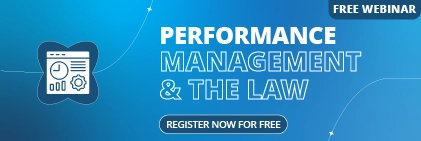The true cost of losing a valued employee extends far beyond their final paycheque. In today’s fiercely competitive talent market, Australian businesses are facing unprecedented challenges in retaining their best people.
With talent shortages reaching critical levels across industries, understanding and managing your attrition rate has become more crucial than ever. Every employee departure represents lost knowledge, disrupted productivity, and significant replacement costs that can drain your resources.
Employee attrition rate measures how many employees leave your organisation within a specific timeframe. It’s a critical HR metric that reveals the health of your workplace culture, management effectiveness, and overall employee satisfaction.
Sentrient’s comprehensive HR and compliance solutions help Australian businesses track, analyse, and reduce attrition through integrated people management systems that provide actionable insights into employee retention patterns.
This guide will walk you through calculating attrition rates, identifying warning signs, understanding root causes, and implementing proven strategies to keep your best talent engaged and committed to your organisation’s success.
What is Attrition Rate?
Attrition rate indicates the pace at which employees exit a company—either by choice or through termination. Represented as a percentage, it’s an important metric HR teams use to evaluate organizational stability and workforce health.
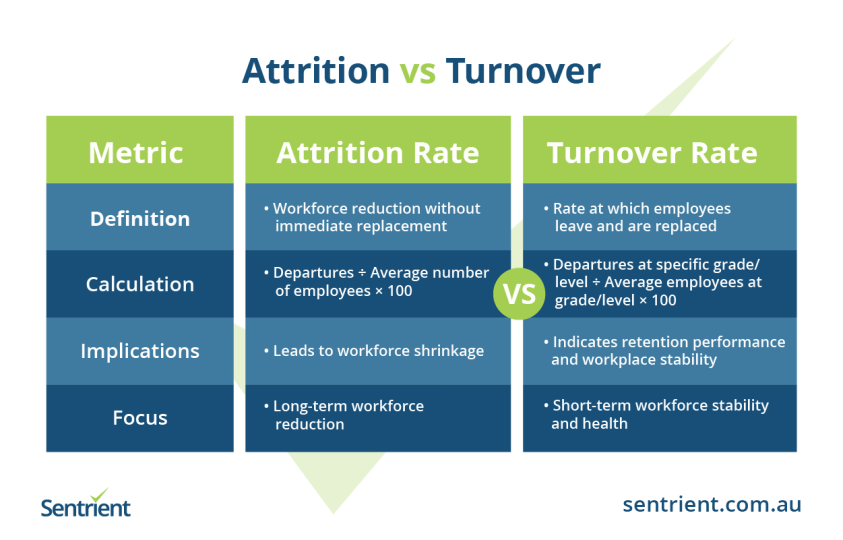
1. Attrition vs. Turnover vs. Retention
- Employee attrition refers to the natural reduction in workforce size through resignations, retirements, or redundancies without immediate replacement. It’s often permanent workforce reduction.
- Employee turnover involves replacing departing employees with new hires, maintaining consistent staffing levels. Turnover focuses on the replacement cycle rather than workforce reduction.
- Employee retention measures your ability to keep employees over time, typically expressed as a percentage of staff remaining during a specific period.
| Metric | Definition | When to Use |
|---|---|---|
| Attrition Rate | % of employees who left without replacement | Workforce planning, cost analysis |
| Turnover Rate | % of employees replaced during period | Recruitment planning, HR efficiency |
| Retention Rate | % of employees who stayed during period | Engagement measurement, culture assessment |
2. Types of Employee Attrition
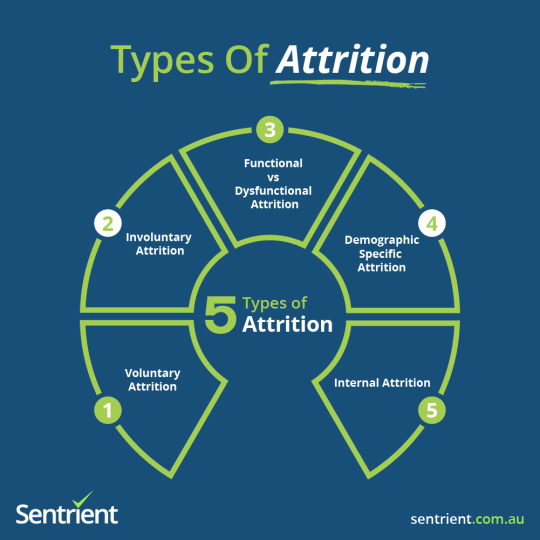
- Voluntary Attrition: Employees choose to leave for new opportunities, career changes, or personal reasons. This includes resignations, career breaks, and voluntary redundancies.
- Involuntary Attrition: Organisation-initiated departures including performance dismissals, restructuring redundancies, and contract terminations.
- Functional vs. Dysfunctional Attrition: Functional attrition removes underperforming employees, whilst dysfunctional attrition loses valuable talent you want to retain.
- Demographic-Specific Attrition: Patterns affecting particular groups like graduates, senior executives, or specific departments that require targeted retention strategies.
- Internal Attrition: Movement within the organisation through promotions, transfers, or role changes that may still require replacement and retraining.
3. Industry Benchmarks and Acceptable Rates
Acceptable attrition rates vary significantly across Australian industries. Healthcare and education typically see 10-15% annual rates, whilst technology and consulting sectors may experience 20-25%.
Small businesses (5-50 employees) should target rates below 15% annually, as each departure has proportionally greater impact. Medium enterprises (50-200 employees) can typically manage 12-18% rates effectively.
How to Calculate Employee Attrition Rate
1. Basic Attrition Rate Formula
The standard attrition rate formula provides a clear percentage of workforce reduction:
Attrition Rate = (Number of Employees Who Left ÷ Average Number of Employees) × 100
Step-by-step calculation process:
- Count total employees who left during the period
- Calculate average workforce size: (Starting employees + Ending employees) ÷ 2
- Divide departures by average workforce
- Multiply by 100 for percentage
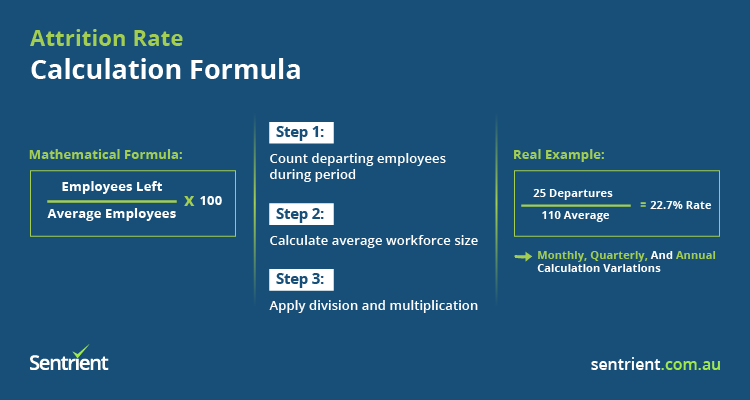
2. Detailed Calculation Examples
Annual Attrition Rate Example:
- Quarterly Calculation: For more frequent monitoring, apply the same formula quarterly then annualise by multiplying by four for comparative analysis.
- Complex Scenarios: When hiring occurs during the measurement period, use monthly averages or weighted calculations to account for workforce fluctuations and ensure accuracy.
3. Advanced Attrition Metrics
- Voluntary vs. Involuntary Rates: Calculate separately to identify whether departures stem from employee dissatisfaction or organizational decisions.
- New Hire Attrition: Track departures within first 12 months to evaluate recruitment management system effectiveness and onboarding quality.
- Department-Specific Rates: Analyse patterns across teams to identify problematic areas requiring targeted intervention strategies.
What are the Risk Factors and Warning Signs?
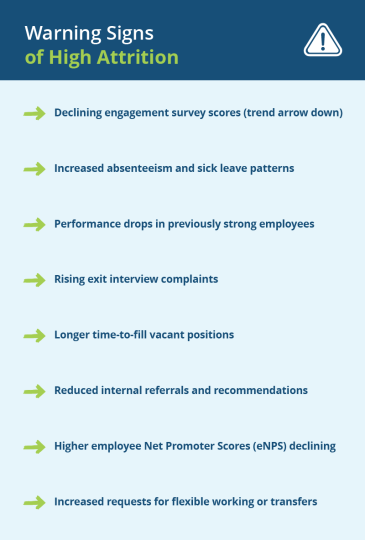
1. Early Warning Indicators
Declining employee engagement scores often precede departures by 3-6 months. Regular pulse surveys can capture shifting sentiment before it translates into resignations.
Increased absenteeism patterns frequently signal disengagement, stress, or job searching activities. Monitor unusual leave patterns, especially among high performers.
Performance dips in previously strong employees may indicate loss of motivation, insufficient support, or consideration of external opportunities.
2. Additional Metrics to Track
- Employee retention rate by department and tenure
- Employee Net Promoter Score (eNPS) for advocacy measurement
- Time-to-fill vacant positions indicating market competitiveness
- Exit interview feedback themes revealing systemic issues
3. Conducting Employee Attrition Analysis
Gather comprehensive data from HRIS systems, performance reviews, and employee feedback platforms. Sentrient’s integrated reporting capabilities streamline this analysis process.
Identify patterns across demographics, departments, managers, and timeframes to pinpoint specific risk factors and intervention opportunities.
Why Do Employees Leave?
1. Compensation and Benefits Issues
Below-market pay structures drive talent to competitors offering better financial packages. Regular benchmarking against industry standards prevents compensation-related departures.
Inadequate benefits packages including healthcare, superannuation, and flexible working arrangements increasingly influence retention decisions, particularly among younger employees.
2. Career Development Limitations
Limited growth opportunities frustrate ambitious employees seeking advancement. Clear career pathways and promotion transparency demonstrate organisational commitment to employee futures.
Insufficient learning management programmes leave employees feeling stagnant. Investment in skills development shows value for employee growth whilst building internal capability.
3. Management and Leadership Problems
Poor management practices including micromanagement, unclear expectations, and inconsistent communication create toxic working relationships that drive departures.
Lack of regular feedback leaves employees uncertain about performance and growth areas. Structured feedback systems improve engagement and development outcomes.
4. Company Culture and Work Environment
Toxic workplace culture characterized by bullying, discrimination, or unrealistic pressure creates unsustainable working conditions leading to inevitable departures.
Work-life balance issues including excessive overtime, inflexible arrangements, and burnout culture increasingly influence retention decisions in post-pandemic workplaces.
5. Job Design and Role Satisfaction
Misaligned expectations between job descriptions and actual responsibilities create disappointment and early departures, particularly among new hires.
Lack of autonomy in decision-making and task management frustrates experienced professionals seeking meaningful contribution and responsibility.
What Does High Attrition Cost?
1. Direct Financial Costs
Recruitment and hiring expenses typically range from 50% to 200% of the departing employee’s annual salary, including advertising, interviewing, and agency fees.
Training and onboarding costs for replacement employees include time investment from existing staff, reduced productivity during learning periods, and formal training programme expenses.
2. Indirect Costs and Consequences
Productivity loss during transitions affects team performance, project timelines, and customer service quality whilst replacement employees develop proficiency.
Knowledge drain and intellectual capital loss occurs when experienced employees take specialised skills, client relationships, and institutional knowledge to competitors.
Impact on team morale creates cascading effects as remaining employees face increased workloads, uncertainty, and potential consideration of their own employment options.
3. ROI of Retention Investments
Research demonstrates that effective retention programmes deliver 3:1 return on investment through reduced recruitment costs, maintained productivity, and preserved institutional knowledge.
| Investment Area | Cost | ROI Timeframe |
|---|---|---|
| Manager Training | £2,000 per manager | 6–12 months |
| Employee Recognition | £500 per employee | 3–6 months |
| Career Development | £1,500 per employee | 12–18 months |
How to Retain Employees?
1. Developing Employee Value Proposition (EVP)
Creating compelling EVP statements requires understanding what current and potential employees value most about working for your organisation beyond salary.
Aligning EVP with company values ensures authentic messaging that attracts culturally compatible candidates whilst reinforcing organisational identity among existing staff.
Effective EVPs combine tangible benefits with intangible rewards like purpose, growth opportunities, and workplace flexibility that resonate with target demographics.
2. Enhancing Hiring and Onboarding
Better recruitment practices and candidate fit through competency-based interviewing, cultural assessment, and realistic job previews reduce early departures.
Comprehensive onboarding management programmes extending beyond first weeks create stronger connections, clearer expectations, and faster integration into team dynamics.
Structured 90-day check-ins identify adjustment challenges early, enabling proactive support that prevents new hire attrition.
3. Management Excellence Programmes
Training managers as coaches develops skills in motivation, feedback delivery, and team development that directly impact employee satisfaction and retention.
Regular one-on-one meetings create opportunities for career discussions, problem-solving, and relationship building that strengthen manager-employee connections.
Performance management training helps managers recognise achievements, address challenges constructively, and support employee development effectively.
4. Career Development and Growth
Creating clear career paths with defined progression criteria and timeframes gives employees tangible goals and reduces uncertainty about advancement opportunities.
Professional development opportunities including conferences, certifications, and internal training programmes demonstrate investment in employee growth and capabilities.
Mentorship and coaching programmes pair employees with senior staff for guidance, skill development, and career advice that builds engagement and loyalty.
5. Compensation and Benefits Optimisation
Competitive salary benchmarking ensures pay structures remain attractive compared to market rates and competitor offerings.
Performance-based incentives link rewards to achievements, motivating high performance whilst recognising exceptional contributions appropriately.
Flexible benefits packages allowing choice in healthcare, leave arrangements, and professional development spending accommodate diverse employee preferences.
6. Building Positive Company Culture
Creating inclusive environments where all employees feel valued, respected, and able to contribute authentically reduces turnover risk management among diverse talent.
Employee recognition and reward programmes celebrate achievements regularly, building positive associations with the workplace and reinforcing desired behaviours.
Wellness and wellbeing initiatives including mental health support, fitness programmes, and stress management resources address holistic employee needs.
Technology and Analytics for Employee Retention
1. HR Analytics Platforms
HRIS systems for data tracking centralise employee information, enabling comprehensive analysis of retention patterns, performance trends, and engagement metrics.
Predictive analytics for attrition risk identify employees likely to leave based on historical patterns, engagement scores, and behavioural indicators.
Sentrient’s integrated analytics dashboard provides real-time insights into workforce trends, enabling proactive retention interventions before employees decide to leave.
2. Employee Listening Tools
Pulse surveys and continuous feedback capture employee sentiment regularly, identifying emerging issues before they escalate into departure decisions.
Employee journey analytics map touchpoints from recruitment through exit, highlighting critical moments requiring attention or improvement.
3. Performance Management Systems
Goal setting and tracking platforms align individual objectives with organisational priorities whilst providing clear progress measurement and recognition opportunities.
Regular feedback mechanisms facilitate ongoing performance discussions, career planning, and development support that strengthens employee engagement.
Employee Feedback Systems
1. Pulse Surveys and Continuous Listening
Implementing regular pulse surveys provides ongoing sentiment monitoring without survey fatigue, capturing employee mood shifts and emerging concerns promptly.
Real-time feedback collection through digital platforms enables immediate response to workplace issues, demonstrating organisational responsiveness and care.
Short, focused surveys covering engagement, wellbeing, and satisfaction deliver actionable insights whilst respecting employee time and attention.
2. Employee Journey Analytics
Mapping critical employee touchpoints from initial application through offboarding identifies moments requiring enhanced attention or improved processes.
Identifying intervention opportunities enables proactive support during challenging periods like role transitions, organisational changes, or performance challenges.
Data-driven journey mapping reveals patterns in employee experience that inform targeted improvements and personalised support strategies.
3. Exit Interviews and Offboarding Excellence
Structured exit interview processes gather honest feedback about employee experience, management effectiveness, and organisational improvement opportunities.
Learning from departing employees provides valuable insights into systemic issues requiring attention and successful practices worth preserving.
Alumni networks and boomerang employee strategies maintain positive relationships with former staff who may return with enhanced skills and external experience.
Sentrient’s comprehensive exit interview templates and analysis tools help organisations capture and act on departure feedback effectively.
Measuring and Monitoring Retention Efforts
1. Key Performance Indicators (KPIs)
Retention rate improvements measured quarterly and annually demonstrate programme effectiveness and identify areas requiring additional attention or resources.
Engagement score trends tracked through regular surveys reveal correlation between employee satisfaction and retention outcomes.
Monitor metrics including time-to-fill positions, internal promotion rates, and employee referral percentages for comprehensive retention assessment.
2. Regular Assessment and Adjustment
Quarterly retention reviews examine programme effectiveness, resource allocation, and emerging challenges requiring strategic response or tactical modifications.
Strategy effectiveness evaluation compares costs invested in retention initiatives against savings from reduced turnover and improved productivity.
Continuous improvement processes ensure retention strategies evolve with changing workforce expectations and market conditions.
3. Benchmarking and Industry Comparisons
External benchmarking practices compare organizational performance against industry standards and competitor practices for realistic goal setting.
Best practice identification through industry research and peer networking reveals innovative approaches and proven strategies worth adopting.
Building a Retention Culture
1. Leadership Commitment and Accountability
Executive sponsorship demonstrates organizational commitment to retention whilst providing necessary resources and strategic support for programme success.
Manager accountability for retention includes metrics in performance evaluations, ensuring frontline leaders prioritise employee engagement and development.
Leadership modelling of retention-focused behaviours sets organisational tone and expectations for employee treatment and development investment.
2. Creating Sustainable Retention Programmes
Long-term planning approaches consider workforce demographics, succession requirements, and strategic business needs for comprehensive retention strategy development.
Resource allocation strategies balance immediate intervention needs with sustainable programme funding that maintains effectiveness over time.
Integration with business planning ensures retention strategies align with organisational growth, market changes, and strategic priorities.
3. Future-Proofing Your Retention Strategy
Adapting to workforce changes including generational differences, technology adoption, and evolving work preferences maintains programme relevance and effectiveness.
Emerging trends and challenges such as remote work, gig economy growth, and skills shortages require flexible, responsive retention approaches.
Continuous learning from retention research, industry developments, and employee feedback keeps strategies current and competitive.
Conclusion
Managing employee attrition effectively requires strategic thinking, consistent measurement, and proactive intervention. The strategies outlined in this guide provide a comprehensive framework for understanding, calculating, and reducing unwanted departures whilst building a retention-focused organizational culture.
Successful retention programmes combine accurate measurement, root cause analysis, and targeted interventions that address both immediate concerns and long-term employee needs. By implementing these evidence-based approaches, Australian businesses can protect their talent investments whilst creating engaging workplaces that attract and retain exceptional people.
Sentrient’s integrated HR and compliance platform empowers organisations to track attrition metrics, identify risk factors, and implement retention strategies through comprehensive people management solutions. Our Australian-designed system provides the tools, templates, and analytics needed to build effective retention programmes that protect your most valuable asset – your people.
The competitive talent market demands proactive retention strategies backed by data-driven insights and employee-centric policies. Don’t wait for valuable employees to leave – start building your retention-focused culture today with expert guidance and proven solutions.
Transform your employee retention approach with Sentrient’s comprehensive HR solutions. Book a personalized free demo to discover how our platform can help you reduce attrition, improve engagement, and build a thriving workplace culture that keeps your best talent engaged and committed.
Take control of your organisation’s future by partnering with Sentrient – Australia’s most reliable HR software solution for sustainable retention success.
Frequently Asked Questions (FAQs)
Q1: What is the difference between attrition and turnover?
Attrition refers to workforce reduction without replacement, whilst turnover involves replacing departing employees. Attrition is typically permanent workforce downsizing, whereas turnover maintains staffing levels.
Q2: What is considered a good attrition rate?
Annual attrition rates below 15% are generally acceptable for most industries. However, rates vary by sector, with technology companies experiencing 20-25% whilst healthcare typically sees 10-15%.
Q3: How often should we calculate attrition rates?
Calculate attrition rates monthly for trending analysis and quarterly for reporting purposes. Annual calculations provide strategic insights, whilst more frequent measurement enables proactive intervention.
Q4: What is the most effective retention strategy?
Effective management and clear career development opportunities consistently rank as top retention drivers. Investment in manager training and structured career paths delivers strongest retention results.
Q5: How can small companies compete with larger organisations for talent?
Small companies should emphasise flexibility, growth opportunities, and personal development. Competitive benefits, strong culture, and direct access to leadership often outweigh larger company resources.
Q6: When is high attrition beneficial?
High attrition can benefit organisations when removing underperforming employees, during restructuring periods, or when upgrading skills. Functional attrition improves overall team quality and performance.
Q7: What role does remote work play in attrition rates?
Remote work flexibility significantly improves retention among knowledge workers. Companies offering hybrid arrangements report 25-30% lower attrition rates compared to traditional office-only policies.



